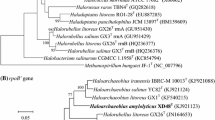Abstract.
The extremely halophilic actinomycete Actinopolyspora halophila is a rare example of a heterotrophic eubacterium producing betaine from simple carbon sources. A. halophila synthesized remarkably high intracellular concentrations of betaine. The highest betaine concentration, determined at 24% (w/v) NaCl, was 33% of the cellular dry weight. Trehalose was synthesized as a compatible solute, accounting for up to 9.7% of the cellular dry weight. The betaine concentration was shown to increase with increasing NaCl concentration, whereas the trehalose concentration was highest at the lowest NaCl concentration used (15% w/v). A. halophila was capable of accumulating betaine from the medium, while at the same time betaine was also excreted back into the medium by the cells. Along with the de novo synthesis of betaine, A. halophila was able to take up choline from the medium and oxidize it to betaine. Some basic characteristics of the choline oxidation system are described. Choline was oxidized to betaine aldehyde in a reaction in which H2O2 generation and oxygen consumption were coupled. Betaine aldehyde was also oxidized, but with lesser efficiency. In addition, betaine aldehyde was oxidized further to betaine in a reaction in which NAD(P)+ was reduced.
Similar content being viewed by others
Author information
Authors and Affiliations
Additional information
Electronic Publication
Rights and permissions
About this article
Cite this article
Nyyssölä, A., Leisola, M. Actinopolyspora halophila has two separate pathways for betaine synthesis. Arch Microbiol 176, 294–300 (2001). https://doi.org/10.1007/s002030100325
Received:
Revised:
Accepted:
Issue Date:
DOI: https://doi.org/10.1007/s002030100325




